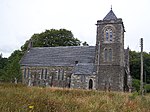Ardhallow Battery
Ardhallow Battery a Palmerston Fort on the slopes of Corlarach Hill on the Cowal peninsula, around 3km south of Dunoon, on the west coast of the Firth of Clyde, Scotland. Part of the local Clyde Defenses and the Scottish Coastal Defences. The construction contract was awarded to "The Aitkenhead Builders" in 1901 for a price of £16,000. The Battery is a Scheduled Monument. The site was used in both World Wars and decommissioned in 1956. There was also a coastal Battery on the east shore of the Firth of Clyde, the Cloch Point Battery was located on the slope above the Cloch Lighthouse. Enhanced and expanded for defence during the Second World War. It is also a Scheduled Monument: SM12803 The site is now occupied by the Cloch Caravan Park. During both World Wars, a defensive boom, known as the Cloch Point To Dunoon Anti-submarine Boom was in place. Remains of the Boom anchor points are also scheduled SM12802. These installationswere were built to protect the upper Firth of Clyde shipping and the numerous shipyards located on the lower reaches of the River Clyde.
Excerpt from the Wikipedia article Ardhallow Battery (License: CC BY-SA 3.0, Authors).Ardhallow Battery
Bullwood Road,
Geographical coordinates (GPS) Address Nearby Places Show on map
Geographical coordinates (GPS)
| Latitude | Longitude |
|---|---|
| N 55.925833333333 ° | E -4.9422222222222 ° |
Address
Bullwood Road
Bullwood Road
PA23 7QN
Scotland, United Kingdom
Open on Google Maps









